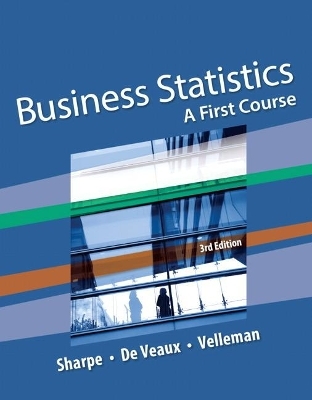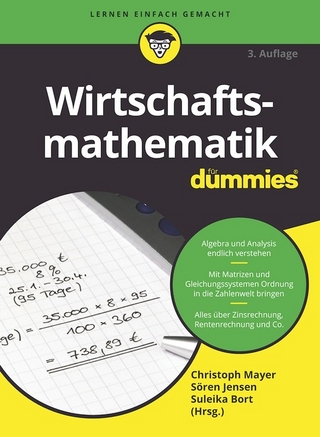
Business Statistics
Pearson (Verlag)
978-0-13-418244-5 (ISBN)
- Titel erscheint in neuer Auflage
- Artikel merken
Better Decisions. Better Results.
Business Statistics: A First Course, Third Edition, by Sharpe, De Veaux, and Velleman, narrows the gap between theory and practice–relevant statistical methods empower business students to make effective, data-informed decisions. With their unique blend of teaching, consulting, and entrepreneurial experiences, this dynamic author team brings a modern edge to teaching statistics to business students. Focusing on statistics in the context of real business issues—with an emphasis on analysis and understanding over computation—the text helps students think analytically, prepares them to make better business decisions, and shows them how to effectively communicate results.
KEY TOPICS: EXPLORING AND COLLECTING DATA: Data and Decisions, Displaying and Describing Categorical Data, Displaying and Describing Quantitative Data, Correlation and Linear Regression, MODELING WITH PROBABILITY: Randomness and Probability, Random Variables and Probability Models, The Normal and Other Continuous Distributions, Surveys and Sampling, Sampling Distributions and Confidence Intervals for Proportions, INFERENCE FOR DECISION MAKING: Testing Hypotheses about Proportions, Confidence Intervals and Hypothesis Tests for Means, Comparing Two Means, Inference for Counts: Chi-Square Tests, Inference for Regression, Multiple Regression, SELECTED TOPICS IN DECISION MAKING: Introduction to Data Mining
MARKET: For all readers interested in business statistics.
As a researcher of statistical problems in business and a professor of Statistics at a business school, Norean Radke Sharpe (Ph.D. University of Virginia) understands the challenges and specific needs of the business student. She is currently teaching at the McDonough School of Business at Georgetown University, where she is also Senior Associate Dean and Director of Undergraduate Programs. Prior to joining Georgetown, she taught business statistics and operations research courses to both undergraduate and MBA students for fourteen years at Babson College. Before moving into business education, she taught statistics for several years at Bowdoin College and conducted research at Yale University. Norean is coauthor of the recent text, A Casebook for Business Statistics: Laboratories for Decision Making, and she has authored more than 30 articles–primarily in the areas of statistics education and women in science. Norean currently serves as Associate Editor for the journal Cases in Business, Industry, and Government Statistics. Her research focuses on business forecasting and statistics education. She is also co-founder of DOME Foundation, Inc., a nonprofit foundation that works to increase Diversity and Outreach in Mathematics and Engineering for the greater Boston area. She has been active in increasing the participation of women and underrepresented students in science and mathematics for several years and has two children of her own. Richard D. De Veaux (Ph.D. Stanford University) is an internationally known educator, consultant, and lecturer. Dick has taught statistics at a business school (Wharton), an engineering school (Princeton), and a liberal arts college (Williams). While at Princeton, he won a Lifetime Award for Dedication and Excellence in Teaching. Since 1994, he has taught at Williams College, although he returned to Princeton for the academic year 2006—2007 as the William R. Kenan Jr. Visiting Professor of Distinguished Teaching. He is currently the C. Carlisle and Margaret Tippit Professor of Statistics at Williams College. Dick holds degrees from Princeton University in Civil Engineering and Mathematics and from Stanford University in Dance Education and Statistics, where he studied with Persi Diaconis. His research focuses on the analysis of large data setsand data mining in science and industry. Dick has won both the Wilcoxon and Shewell awards from the American Society for Quality. He is an elected member of the International Statistics Institute (ISI) and a Fellow of the American Statistical Association (ASA). He currently serves on the Board of Directors of the ASA. Dick is well known in industry, having consulted for such Fortune 500 companies as American Express, Hewlett-Packard, Alcoa, DuPont, Pillsbury, General Electric, and Chemical Bank. He was named the “Statistician of the Year” for 2008 by the Boston Chapter of the American Statistical Association for his contributions to teaching, research, and consulting. In his spare time he is an avid cyclist and swimmer. He also is the founder and bass for the doo-wop group, the Diminished Faculty, and is a frequent singer and soloist with various local choirs including the Choeur Vittoria of Paris, France. Dick is the father of four children. Paul F. Velleman (Ph.D. Princeton University) has an international reputation for innovative statistics education. He designed the Data Desk® software package and is also the author and designer of the award-winning ActivStats® multimedia software, for which he received the EDUCOM Medal for innovative uses of computers in teaching statistics and the ICTCM Award for Innovation in Using Technology in College Mathematics. He is the founder and CEO of Data Description, Inc. (www.datadesk.com), which supports both of these programs. He also developed the Internet site, Data and Story Library (DASL; lib.stat.cmu.edu/DASL/), which provides data sets for teaching Statistics. Paul coauthored (with David Hoaglin) the book ABCs of Exploratory Data Analysis. Paul teaches Statistics at Cornell University in the Department of Statistical Sciences and in the School of Industrial and Labor Relations, for which he has been awarded the MacIntyre prize for Exemplary Teaching. His research often focuses on statistical graphics and data analysis methods. Paul is a Fellow of the American Statistical Association and of the American Association for the Advancement of Science. Paul’s experience as a professor, entrepreneur, and business leader brings a unique perspective to the book. Richard De Veaux and Paul Velleman have authored successful books in the introductory college and AP High School market with David Bock, including Intro Stats, Fourth Edition (Pearson, 2014), Stats: Modeling the World, Fourth Edition (Pearson, 2015), and Stats: Data and Models, Fourth Edition (Pearson, 2016).
<>Preface
Index of Applications
Part I: Exploring and Collecting Data
1. Data and Decisions (E-Commerce)
1.1 What Are Data?
1.2 Variable Types
1.3 Data Sources: Where, How, and When
Ethics in Action
Technology Help: Data
Brief Case: Credit Card Bank
2. Displaying and Describing Categorical Data (KEEN, Inc.)
2.1 Summarizing a Categorical Variable
2.2 Displaying a Categorical Variable
2.3 Exploring Two Categorical Variables: Contingency Tables
2.4 Segmented Bar Charts and Mosaic Plots
2.5 Simpson’s Paradox
Ethics in Action
Technology Help: Displaying Categorical Data
Brief Case: Credit Card Bank
3. Displaying and Describing Quantitative Data (AIG)
3.1 Displaying Quantitative Variables
3.2 Shape
3.3 Center
3.4 Spread of the Distribution
3.5 Shape, Center, and Spread–A Summary
3.6 Standardizing Variables
3.7 Five-Number Summary and Boxplots
3.8 Comparing Groups
3.9 Identifying Outliers
3.10 Time Series Plots
*3.11 Transforming Skewed Data
Ethics in Action
Technology Help: Displaying and Summarizing Quantitative Variables
Brief Cases: Detecting the Housing Bubble and Socio-Economic Data on States
4. Correlation and Linear Regression (Amazon.com)
4.1 Looking at Scatterplots
4.2 Assigning Roles to Variables in Scatterplots
4.3 Understanding Correlation
4.4 Lurking Variables and Causation
4.5 The Linear Model
4.6 Correlation and the Line
4.7 Regression to the Mean
4.8 Checking the Model
4.9 Variation in the Model and R2
4.10 Reality Check: Is the Regression Reasonable?
4.11 Nonlinear Relationships
Ethics in Action
Technology Help: Correlation and Regression
Brief Cases: Fuel Efficiency, Cost of Living, and Mutual Funds
Case Study I: Paralyzed Veterans of America
Part II: Modeling with Probability
5. Randomness and Probability (Credit Reports and the Fair Isaacs Corporation)
5.1 Random Phenomena and Probability
5.2 The Nonexistent Law of Averages
5.3 Different Types of Probability
5.4 Probability Rules
5.5 Joint Probability and Contingency Tables
5.6 Conditional Probability
5.7 Constructing Contingency Tables
5.8 Probability Trees
*5.9 Reversing the Conditioning: Bayes’ Rule
Ethics in Action
Technology Help: Generating Random Numbers
Brief Case: Global Markets
6. Random Variables and Probability Models (Metropolitan Life Insurance Company)
6.1 Expected Value of a Random Variable
6.2 Standard Deviation of a Random Variable
6.3 Properties of Expected Values and Variances
6.4 Bernoulli Trials
6.5 Discrete Probability Models
Ethics in Action
Technology Help: Random Variables and Probability Models
Brief Case: Investment Options
7. The Normal and Other Continuous Distributions (The NYSE)
7.1 The Standard Deviation as a Ruler
7.2 The Normal Distribution
7.3 Normal Probability Plots
7.4 The Distribution of Sums of Normals
7.5 The Normal Approximation for the Binomial
7.6 Other Continuous Random Variables
Ethics in Action
Technology Help: Probability Calculations and Plots
Brief Case: Price/Earnings and Stock Value
8. Surveys and Sampling (Roper Polls)
8.1 Three Ideas of Sampling
8.2 Populations and Parameters
8.3 Common Sampling Designs
8.4 The Valid Survey
8.5 How to Sample Badly
Ethics in Action
Technology Help: Random Sampling
Brief Cases: Market Survey Research and The GfK Roper Reports Worldwide Survey
9. Sampling Distributions and Confidence Intervals for Proportions (Marketing Credit Cards: The MBNA Story)
9.1 The Distribution of Sample Proportions
9.2 The Sampling Distribution for Proportions
9.3 A Confidence Interval for a Proportion
9.4 Margin of Error: Certainty vs. Precision
9.5 Choosing the Sample Size
Ethics in Action
Technology Help: Confidence Intervals for Proportions
Brief Cases: Has Gold Lost Its Luster? and Forecasting Demand
Case Study II: Real Estate Simulation
Part III: Inference for Decision Making
10. Testing Hypotheses about Proportions (Dow Jones Industrial Average)
10.1 Hypotheses
10.2 A Trial as a Hypothesis Test
10.3 P-Values
10.4 The Reasoning of Hypothesis Testing
10.5 Alternative Hypotheses
10.6 Alpha Levels and Significance
10.7 Critical Values
10.8 Confidence Intervals and Hypothesis Tests
10.9 Two Types of Errors
10.10 Power
Ethics in Action
Technology Help: Hypothesis Tests
Brief Cases: Metal Production, Loyalty Program, and Confidence Intervals and Hypothesis Tests
11. Confidence Intervals and Hypothesis Tests for Means (Guinness & Co.)
11.1 The Central Limit Theorem
11.2 The Sampling Distribution of the Mean
11.3 How Sampling Distribution Models Work
11.4 Gosset and the t-Distribution
11.5 A Confidence Interval for Means
11.6 Assumptions and Conditions
11.7 Testing Hypotheses about Means–the One-Sample t-Test
Ethics in Action
Technology Help: Inference for Means
Brief Cases: Real Estate and Donor Profiles
12. Comparing Two Means (Visa Global Organization)
12.1 Comparing Two Means
12.2 The Two-Sample t-Test
12.3 Assumptions and Conditions
12.4 A Confidence Interval for the Difference Between Two Means
12.5 The Pooled t-Test
12.6 Paired Data
12.7 Paired t-Methods
Ethics in Action
Technology Help: Comparing Two Groups
Brief Cases: Real Estate and Consumer Spending Patterns (Data Analysis)
13. Inference for Counts: Chi-Square Tests (SAC Capital)
13.1 Goodness-of-Fit Tests
13.2 Interpreting Chi-Square Values
13.3 Examining the Residuals
13.4 The Chi-Square Test of Homogeneity
13.5 Comparing Two Proportions
13.6 Chi-Square Test of Independence
Ethics in Action
Technology Help: Chi-Square
Brief Cases: Health Insurance and Loyalty Program
Case Study III: Investment Strategy Segmentation
Part IV Models for Decision Making
14. Inference for Regression (Nambé Mills)
14.1 A Hypothesis Test and Confidence Interval for the Slope
14.2 Assumptions and Conditions
14.3 Standard Errors for Predicted Values
14.4 Using Confidence and Prediction Intervals
Ethics in Action
Technology Help: Regression Analysis
Brief Cases: Frozen Pizza and Global Warming?
15. Multiple Regression (Zillow.com)
15.1 The Multiple Regression Model
15.2 Interpreting Multiple Regression Coefficients
15.3 Assumptions and Conditions for the Multiple Regression Model
15.4 Testing the Multiple Regression Model
15.5 Adjusted R2 and the F-statistic
*15.6 The Logistic Regression Model
Ethics in Action
Technology Help: Regression Analysis
Brief Case: Golf Success
Part V: Selected Topics in Decision Making
16. Introduction to Data Mining (Paralyzed Veterans of America)
16.1 The Big Data Revolution
16.2 Direct Marketing
16.3 The Goals of Data Mining
16.4 Data Mining Myths
16.5 Successful Data Mining
16.6 Data Mining Problems
16.7 Data Mining Algorithms
16.8 The Data Mining Process
16.9 Summary
Ethics in Action
Case Study V: Marketing Experiment
Appendices
A. Answers
B. Tables and Selected Formulas
C. Photo Acknowledgments
Index
| Erscheinungsdatum | 03.03.2016 |
|---|---|
| Sprache | englisch |
| Maße | 10 x 10 mm |
| Gewicht | 1420 g |
| Themenwelt | Mathematik / Informatik ► Mathematik ► Finanz- / Wirtschaftsmathematik |
| Wirtschaft ► Volkswirtschaftslehre ► Ökonometrie | |
| ISBN-10 | 0-13-418244-8 / 0134182448 |
| ISBN-13 | 978-0-13-418244-5 / 9780134182445 |
| Zustand | Neuware |
| Haben Sie eine Frage zum Produkt? |
aus dem Bereich


